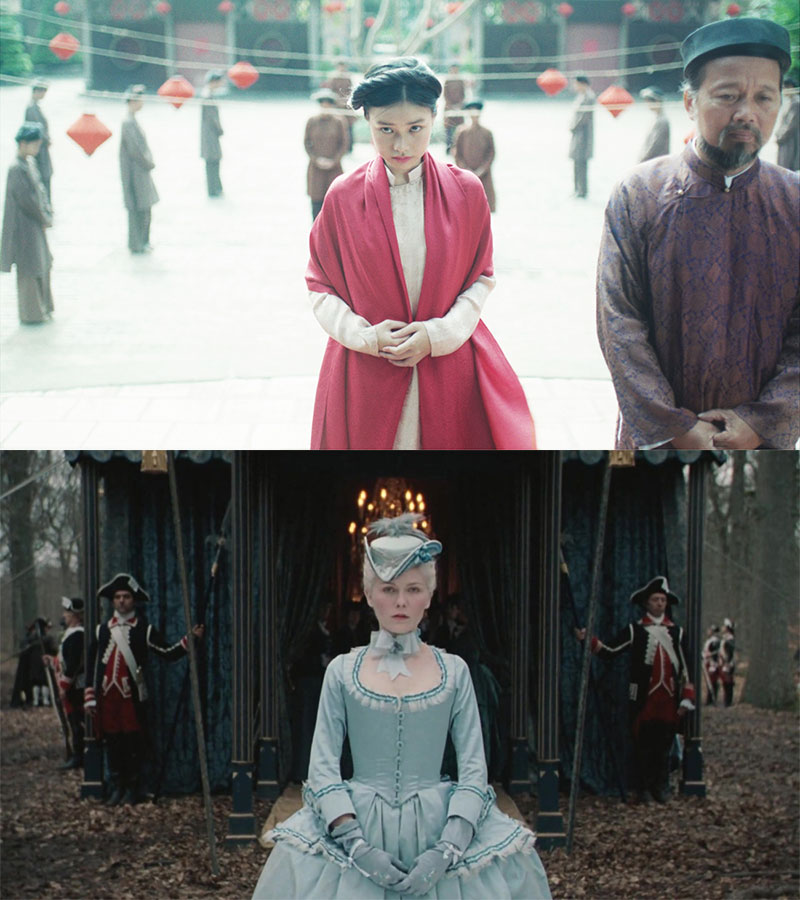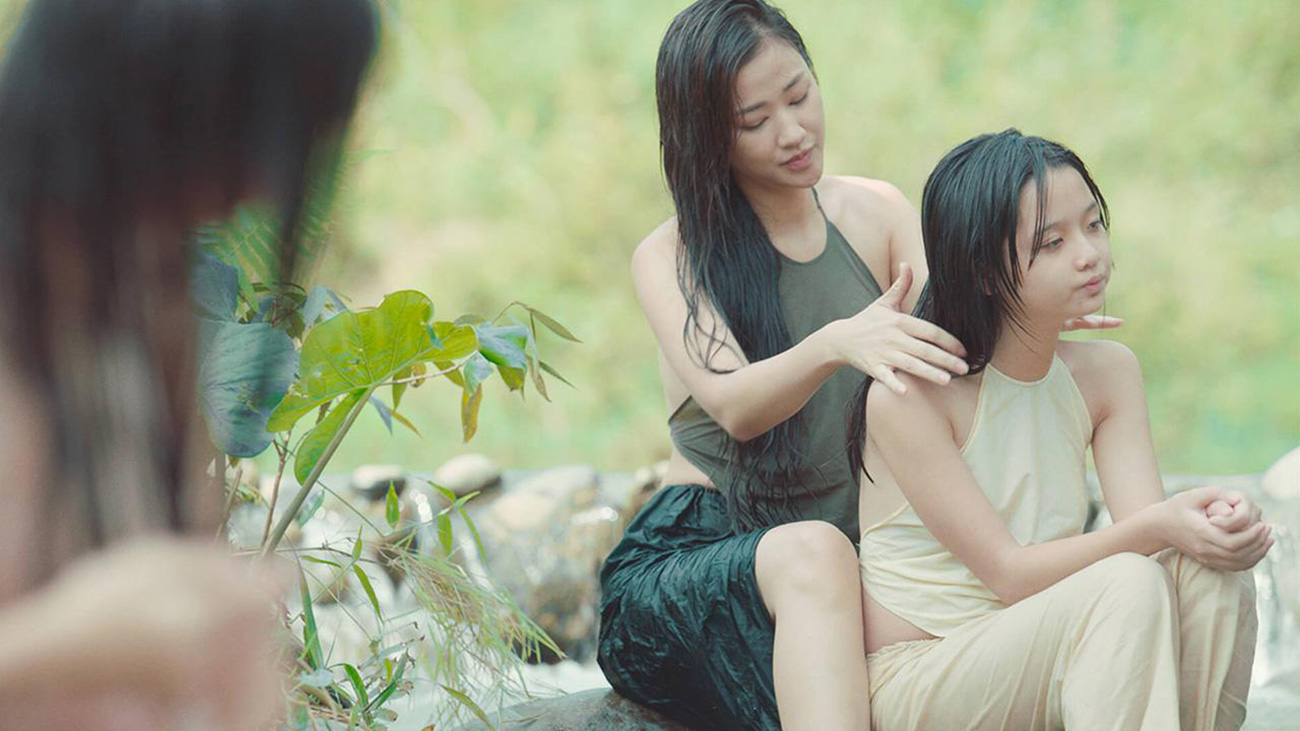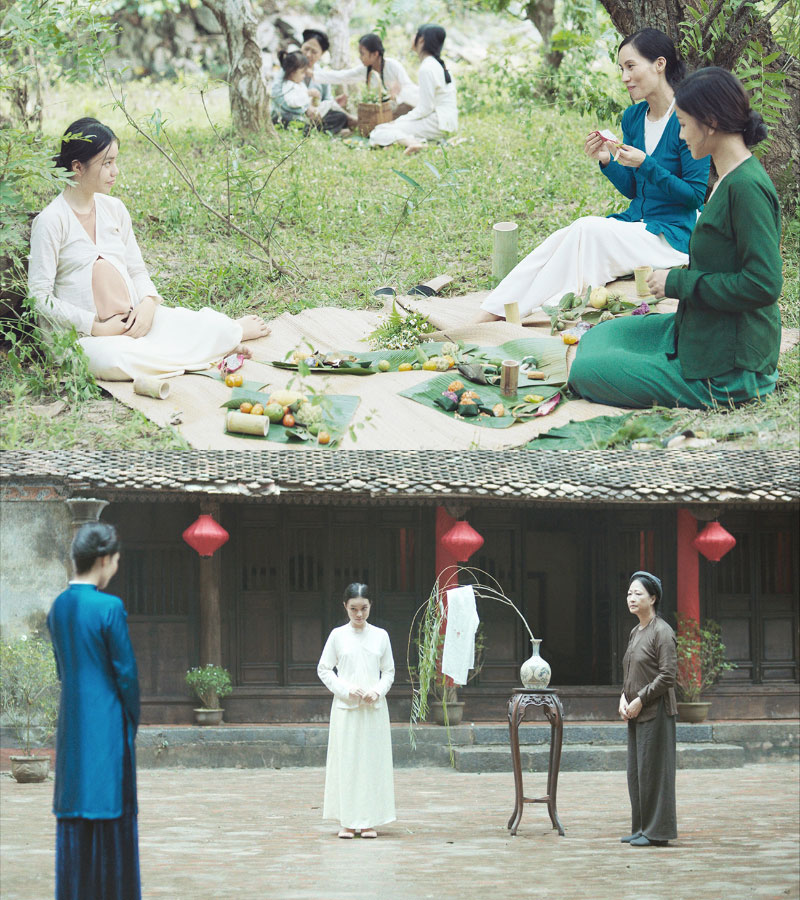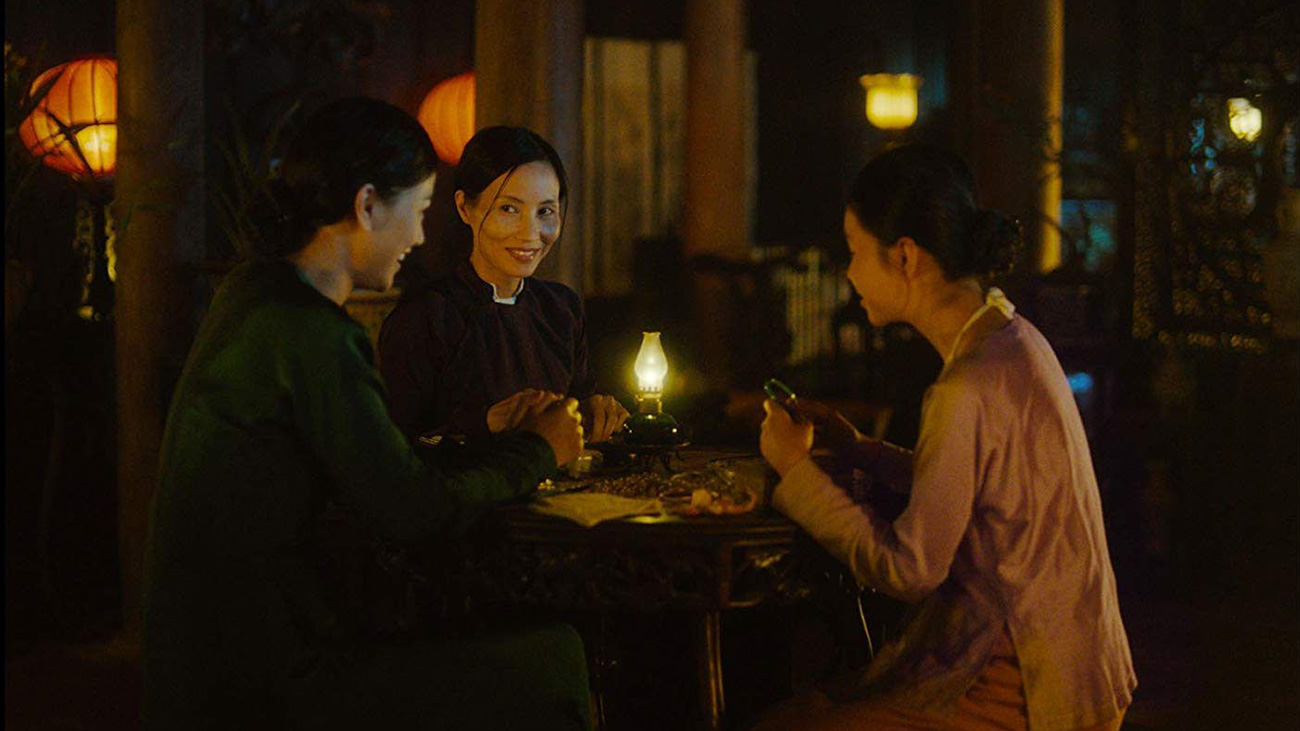Although Ash Mayfair’s debut feature The Third Wife is set in the late 19th century, its depiction of the female condition remains relevant especially to the experiences of women today. In crafting her film, Mayfair (also known as Nguyen Phuong Anh) drew from her personal history and culture to tell a story about the inner lives of women facing the patriarchal structures that limit their existence. Mayfair’s great-grandmother was arranged into a polygamous marriage as a teenager and the film’s content would allow the filmmaker to explore the role of women from a wide range of perspectives.
Fourteen-year-old May (Nguyen Phuong Tra My) is the titular third wife to landowner Hung (Long Le Vu). First wife Ha (Tran Nu Yen Khe) is elegant and respected, having run the household and raised a son and heir. Second wife Xuan (Mai Thu Huong) is beautiful and desirable yet her position in the family is not secure having given birth to three daughters. Xuan’s daughters, Lien (Lam Thanh My) and Nhan (Mai Cat Vi) are important in balancing the film’s observations on girlhood to the experiences of the wives’ own womanhood. And finally we have Auntie (Nguyen Nhu Quynh), who serves as Ha’s right-hand woman in running the household and has her own stories of forgotten dreams as a woman.
The Third Wife relegates its male characters to the fringes of its story, thus allowing the wives and other female characters to take precedence in a film that takes on girlhood and womanhood across a multi-faceted spectrum.
Girlhood

Different eras, same experiences. Ash Mayfair’s “The Third Wife” and Sofia Coppola’s “Marie Antoinette” share the same visual symbolism in this medium shot.
The film opens with May making the journey up a river to become a bride and wife. Across many cultures, water has been associated with emotion and femininity. Water will be an important recurring symbol of femininity in the film. Here, the river symbolises May’s literal journey leaving girlhood behind to become a bride and wife. This scene bears striking similarities to the one in Sofia Coppola’s Marie Antoinette, where another 14-year-old girl made a similar journey to become a bride. The uncertainty and fear in both teenage brides in the matching medium shots as they face their new families is palpable. They are children not ready for marriage, but they don’t have a choice as they are pushed into womanhood in their new bridal finery.
Serving as a foil to May’s meekness is Nhan, Xuan’s second daughter. She is a bold, boisterous child who best represents the girlhood women leave behind once they realise that to survive as a woman is to withdraw more and more into themselves. During a family dinner where Nhan’s grandfather remarks on getting his only male grandchild Son a new horse, Nhan speaks up and asks her grandfather for a horse as well. The camera pans to Xuan’s reaction, a subtle shake of the head and grimace, indicating to her daughter that she is too outspoken for her own good. As writer Chimamanda Ngozi Adichie said in her famous speech, “We teach girls to shrink themselves, to make themselves smaller”. Second-wife Xuan herself perhaps is the most indicative of that statement—a woman who recognises her own nature and makes herself smaller to survive as a female in this world.
Nhan begins to realise the differences between the way males and females are treated and declares one night to her older sister Lien that her dream is to grow up to be a man and have lots of wives. She believes if she prays to Buddha hard enough, her wish will come true. She refuses to simply obey and lashes out at her mother who wants to tame her. Nhan doesn’t actually want to be a man—what she really wants is to be given the same opportunities as boys.
It is therefore deeply significant that Nhan is given the final scene of the film. She stands by the river with scissors too big for such a small girl and chops her long hair off, watching it float down the river. In many Asian cultures, long hair is a highly prized symbol of feminine beauty that’s tied directly with a woman’s worth, especially unmarried girls. The river, which once carried May’s nervous hopes and dreams as a child bride, now carries Nhan’s hair, once tied up in girlish twintails. She looks up and stares defiantly into the camera in the final frame and smiles, breaking the fourth wall. Nhan represents the disobedience of girls who refuse to bend and adhere to the status quo. Using her to break the fourth wall shows that she is, quite literally, unable to be contained by the narrative and refuses to be suppressed just to survive. Her hair floating down the river is a defiant symbol of hope for future generations of girls to come in rebelling against an oppressive patriarchy.

Not a Girl, Not Yet A Woman
All the girls and women in the household share complex and tenuous bonds. Xuan’s eldest daughter Lien is closest in age to May and initially the two young girls bond quickly. But when May becomes pregnant and Lien gets her first period, Ha advises May to spend less time with her as Lien prepares to “become a proper lady”. This distinction marks a shift for both characters. Lien is now in the in-between stage of being not a girl and not yet a woman, while May is fully becoming ‘a woman’ (or as much as she can be as a 14-year-old expectant mother).
Water once again emerges, this time symbolising the delicate transition between girlhood and womanhood in a key scene shortly after Lien gets her first period. May, Xuan and her daughters wash in a stream—Nhan and the toddler girl play together while Xuan helps to wash Lien’s hair as May watches. The emphasis on unbound hair reminds us of May and Xuan’s youthfulness, both of whom appear more like Lien and Nhan’s sisters than their maternal figures. In their usual day-to-day hairstyles, May and Xuan, along with the older female figures, have their hair bound in a low bun while girls like Lien and Nhan wear their hair down in loose ponytails and twintails. It is notable that Lien no longer plays with her sisters and allows her mother to groom her, continuing her gradual transition of ‘becoming’.
Sexual awakening is also a key part of the transition between girlhood and womanhood. Given that May’s wedding night is treated with a mechanical, ritual-like nature despite the rawness of the act (quite literally, as a raw egg is cracked over her body), her real sexual awakening only comes later through Xuan. Xuan is the first person who encourages her to find pleasure in sex with their husband. In the river washing scene, May’s keen eyes flit over Xuan’s wet hair and her womanly body as seen through Xuan’s soaked clothing. Later, May, with her hair unbound, happens across Xuan and Son’s clandestine affair. The scene quickly turns voyeuristic as this discovery arouses her.
Just as unbound hair takes on the meaning of female sexuality in many cultures, the water also signifies the feminine desire that ripples through May as she becomes a woman. She masturbates for the first time to thoughts of Xuan washing her hair by the river that day and Xuan finding sexual pleasure through Son as composer An Ton That’s score climaxes over imagery of the gently rippling river.
Womanhood

Identity and the different facets of womanhood are characterised through the work of costume designer Tran Phuong Thao.
The roles of the film’s three wives and the different facets of women they represent, is visually reinforced also by costume designer Tran Phuong Thao. First-wife Ha is predominantly in Madonna blues, befitting of the matriarch who watches over and organises every member of the house, including her own sister wives. As her story develops, so too does the meaning of Ha’s Madonna blues: from denoting the lack of sexuality in her role as mother and matriarch, to hope when she becomes pregnant, to a solemnity when she miscarries. Through it all however, the blues she wears are inextricably tied to motherhood.
Xuan is portrayed throughout the film as very sexual being and an object of desire for Hung, Son and May. She is always in greens. Green is often associated with desire, but also nature. The significance of Xuan’s colour comes full circle when May follows her out to the forest and witnesses Son performing oral sex on Xuan while she hikes up her green skirts against the backdrop of the verdant forest. It is in this forest where she can be uninhibited and chase her own sexual pleasure. While she may not realise May watching her in this moment, performance and reveling in being seen and desired is part of Xuan’s nature. During May’s wedding, Xuan sings and performs with a green shawl draped across her shoulders and she demonstrates to May how to derive pleasure from sex by treating as though she were “putting on a dance”.
May, as the ingenue, has a shifting colour palette. This is appropriate for a character in the confusing transition from girlhood to womanhood. The pastel, child-like colours she wears in the first half of the story tie her to the younger girls who are often in pinks and whites, reminding us she is essentially, still a child pushed into womanhood by circumstance. As she is discovering who she is and finding her place in the household as an expectant mother and wife, her colours change to a more mature, earth-toned palette.
Throughout the film, imagery of a silkworm’s life cycle are littered throughout. Initially, this seems like an obvious and oft-used metaphor for metamorphosis. Girls are the silkworm that emerge from the cocoon to become a woman. But this metaphor is turned on its head in more ways than one. A woman’s value in a patrilineal society lies in her marriageability, which informs her wifehood and ability to bear sons. Hung’s family harvests silk and the silk is dyed red for the wedding of Ha’s son. Ha, who has just miscarried, has to go on and organise the wedding and walks through this field of freshly dyed red silk thread, reminding us of the blood on her sheets. It is a truly haunting image that reminds us that Ha’s grief is twofold—that of the loss of her unborn child, and of her own value as a woman because she cannot carry a child to term.
Ha’s son, Son, infatuated with Xuan, begs for an annulment to Tuyet, his child bride. Because the marriage was never consummated, his father agrees and even proposes to return the bridal dowry. But in Tuyet’s father’s eyes, she is shameful. To him, Tuyet “cannot even perform her only duty” and he refuses to take her back. Left in limbo, she commits suicide. A silkworm’s life cycle is short. Having been bred in captivity for over a millennial to be used to spin silk, they are entirely dependent on human beings to live. When they spin their silk cocoons, most of the time these silkworms never live long enough to become moths and are killed for those silk cocoons. If they do become moths, years of domestication mean many have lost the ability to fly. Most moths live long enough only to mate, lay eggs and die.
Just like the silkworm, women have historically been valued simply for their domestic labour and ability to breed. Just like the silkworm women have been domesticated and repressed to the point where they lose the ability to do and dream bigger. When you are raised for the singular purpose of marriage so you can bear sons, it is hard to see yourself as anything but worthless when both those options are taken away from you. As May looks upon Tuyet’s still body in her coffin, a single silk moth lands on Tuyet’s face.

With The Third Wife, Mayfair demonstrates tremendous empathy for the women who populate her film and strikes a delicate balance in exploring the complexities of each female character while showing the harsh realities of their situation. Her lack of victimisation makes The Third Wife that much more compelling — this level of restraint is a marvel for a debut filmmaker, and it’s something even veteran filmmakers with decades of experience still struggle with. Mayfair never veers into melodrama or turns her film into something overwrought and preachy in delivering her message.
Yes, the women in this film face oppression and their choices are limited just by nature of having been born female. But despite all the sympathy or outrage you may feel for the characters, this is not a film about female oppression or pain either. Mayfair’s film celebrates all the ways women grow as individuals and bond together. The most indelible images from The Third Wife are those of its women going about their day-to-day activities as they comb each other’s hair, wash each other by the river, sing together in bed or most unforgettably, support and love each other during childbirth.
The Third Wife is about women carrying on and living despite the patriarchal systems that oppress them. It reminds women to continually lift one another up and hold onto these relationships. And for young girls, wisdom is imparted onto them as The Third Wife reminds them to hold onto hope, despite the world them telling them otherwise.
